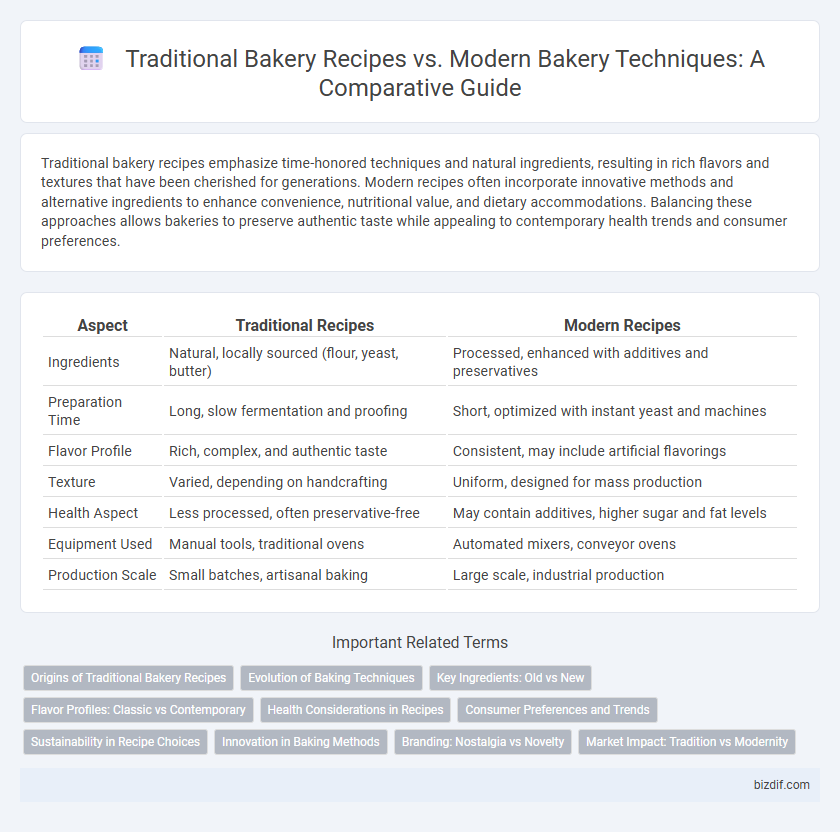Traditional bakery recipes emphasize time-honored techniques and natural ingredients, resulting in rich flavors and textures that have been cherished for generations. Modern recipes often incorporate innovative methods and alternative ingredients to enhance convenience, nutritional value, and dietary accommodations. Balancing these approaches allows bakeries to preserve authentic taste while appealing to contemporary health trends and consumer preferences.
Table of Comparison
| Aspect | Traditional Recipes | Modern Recipes |
|---|---|---|
| Ingredients | Natural, locally sourced (flour, yeast, butter) | Processed, enhanced with additives and preservatives |
| Preparation Time | Long, slow fermentation and proofing | Short, optimized with instant yeast and machines |
| Flavor Profile | Rich, complex, and authentic taste | Consistent, may include artificial flavorings |
| Texture | Varied, depending on handcrafting | Uniform, designed for mass production |
| Health Aspect | Less processed, often preservative-free | May contain additives, higher sugar and fat levels |
| Equipment Used | Manual tools, traditional ovens | Automated mixers, conveyor ovens |
| Production Scale | Small batches, artisanal baking | Large scale, industrial production |
Origins of Traditional Bakery Recipes
Traditional bakery recipes trace their origins to ancient civilizations, where basic ingredients like flour, water, and natural leavening agents were combined to create staple baked goods. These recipes often reflect local cultures and ingredients, passed down through generations to preserve authentic flavors and textures. The emphasis on handcrafted techniques and natural fermentation distinguishes traditional methods from the quicker, ingredient-driven approaches of modern bakery recipes.
Evolution of Baking Techniques
Traditional recipes rely on time-honored methods like slow fermentation and natural leavening to develop rich flavors and textures. Modern recipes incorporate advanced techniques such as molecular gastronomy and precise temperature control, enhancing consistency and innovation. The evolution of baking techniques reflects a blend of preserving authenticity while embracing scientific advancements for improved efficiency and quality.
Key Ingredients: Old vs New
Traditional bakery recipes often rely on foundational ingredients like natural leavening agents, butter, and raw cane sugar to achieve authentic flavors and textures. Modern recipes introduce alternatives such as molecular gastronomy additives, plant-based fats, and refined sweeteners or sugar substitutes to enhance shelf life and cater to dietary preferences. The contrast in key ingredients reflects evolving consumer demands, nutritional trends, and technological advancements in baking.
Flavor Profiles: Classic vs Contemporary
Traditional bakery recipes emphasize rich, deep flavors rooted in time-honored techniques and natural ingredients, delivering comforting, nostalgic tastes. Modern recipes experiment with innovative flavor combinations, incorporating global spices, exotic fruits, and unconventional sweeteners to create dynamic, vibrant profiles. The contrast between classic and contemporary flavor profiles reflects evolving consumer preferences and culinary creativity in bakery arts.
Health Considerations in Recipes
Traditional bakery recipes often use natural ingredients like whole grains, unsweetened fruits, and minimal processed sugars, which can offer higher nutritional value and fewer additives. Modern recipes frequently incorporate alternative flours, sugar substitutes, and plant-based fats to cater to dietary restrictions such as gluten intolerance and veganism. Evaluating health considerations requires balancing authentic flavors with nutrient density, aiming to reduce refined sugars, unhealthy fats, and artificial preservatives in both recipe styles.
Consumer Preferences and Trends
Traditional bakery recipes preserve authentic flavors and time-tested techniques that appeal to consumers seeking nostalgic and artisanal qualities. Modern recipes incorporate innovative ingredients, health-conscious alternatives, and creative flavors to meet growing demands for dietary diversity and convenience. Consumer trends increasingly favor hybrid products that blend traditional methods with contemporary twists, balancing heritage and innovation in bakery offerings.
Sustainability in Recipe Choices
Traditional bakery recipes often rely on locally sourced, seasonal ingredients that minimize environmental impact and support sustainable agriculture. Modern recipes increasingly incorporate plant-based alternatives and whole grain flours, reducing carbon footprints and promoting health-conscious consumption. Both approaches emphasize reducing food waste through precise portioning and using surplus ingredients creatively to enhance sustainability.
Innovation in Baking Methods
Traditional recipes in baking emphasize time-honored techniques such as slow fermentation and hand-kneading to develop deep, rich flavors. Modern recipes introduce innovative methods like high-tech mixers, precise temperature control, and ingredient substitutions to enhance texture and efficiency. Combining classic craftsmanship with contemporary technology results in baked goods that honor tradition while appealing to modern tastes.
Branding: Nostalgia vs Novelty
Traditional bakery recipes leverage nostalgia by emphasizing heritage ingredients and time-honored techniques, appealing to customers seeking authentic, comforting flavors. Modern bakery recipes prioritize novelty, incorporating innovative ingredients and creative presentation to attract adventurous consumers eager for unique taste experiences. Effective branding balances nostalgia's emotional connection with modern recipes' fresh appeal to capture a diverse market.
Market Impact: Tradition vs Modernity
Traditional bakery recipes preserve authentic flavors and attract consumers seeking nostalgic and artisanal products, supporting local markets and small businesses. Modern recipes integrate innovative ingredients and techniques, appealing to health-conscious and experimental customers, thereby expanding market reach and driving trends in convenience and customization. The dynamic between these approaches shapes consumer preferences and retail strategies in the evolving bakery industry.
Traditional Recipes vs Modern Recipes Infographic

 bizdif.com
bizdif.com